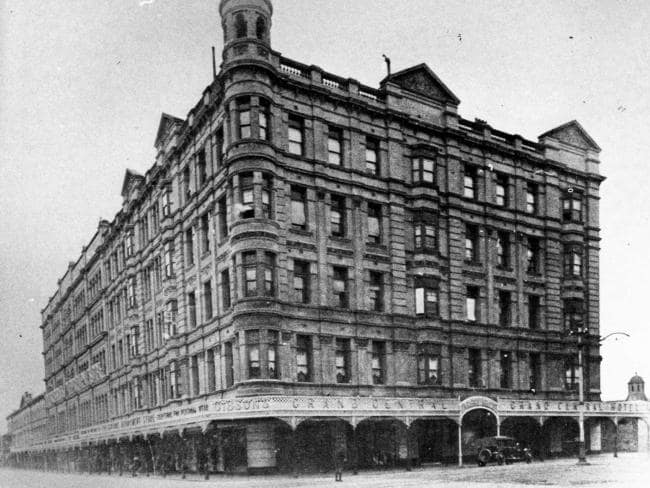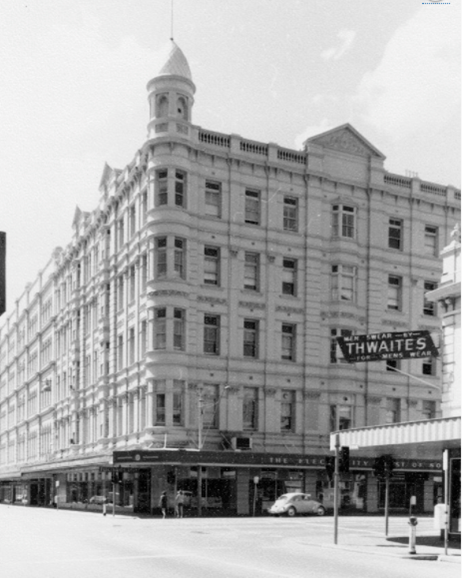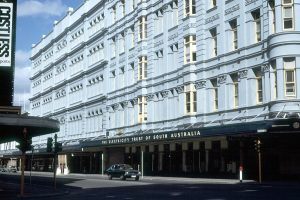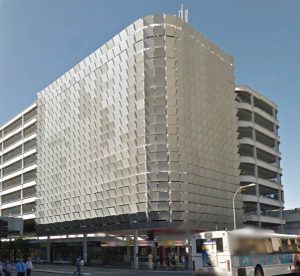WHEN Mark Twain visited Adelaide early last century he chose to stay in the city’s finest lodgings, the Grand Central Hotel on the corner of Pulteney and Rundle streets.
Arthur Conan Doyle, creator of Sherlock Holmes also stayed there and the Prince of Wales (later King Edward Vlll) hosted a royal dinner party in the stately dining room for the Adelaide elite when in residence there in the early 1920s.
Our Grand Central Hotel story begins in the mid-1840s when the colony was just a few years old. The York, a new “public house”, was erected on a Pulteney St site and quickly gained a reputation as one of the finest establishments in the city.
In 1865, it was extensively refurbished to accommodate increasing patronage due to its excellent reputation and proximity to the main shopping area.The Grand Central Hotel, on the southeast corner of Rundle and Pulteney streets, was built in 1910 and was the only kind of high Victorian building in Adelaide.
In 1909 William Gibson, then part owner of the Melbourne department store Foy and Gibson, purchased the York and undertook an ambitious redevelopment program. He flattened the popular hotel to make way for what was to become the city’s most impressive structure.
Completed in 1911, The Grand Central Hotel opened with much fanfare on June 20. It was described by the newspapers of the day as “looking back to high Victorian style” and portrayed as “Adelaide’s own Dorchester”.

The Grand Central Hotel, on the southeast corner of Rundle and Pulteney streets, was built in 1910 and was the only kind of high Victorian building in Adelaide.
Its truly imposing proportions dominated Rundle St. The giant facades were decorated with a complex pattern of string courses, pilasters and mouldings of every description. The bay windows rose to almost the full height of the building, and the corner bow window was capped with an open turret. It was described as “a strictly Edwardian building” and was the only example of high Victorian style that Adelaide possessed.
The hotel boasted 150 rooms plus lounges, two saloons, a billiard room, and writing and smoking rooms. The dining room could accommodate up to 600 people. Other publicised features included an “immense” central light court, electric lifts and artificial heating. The flat roof was intended to house a tennis court and tea garden.
Despite its grandeur and the list of famous guests, the hotel was a disappointment for its investors and not considered a financial success.
The Advertiser reported on November 1, 1924, that “The Grand Central Hotel, Pulteney Street, Adelaide, was formally closed yesterday. “The hotel was very popular among travellers and citizens. Mr P.J. Hennessey informed a representative of The Advertiser that there was no ceremony in connection with the closing. “The upstairs bar would be retained, as a matter of form. The intention in the future was to make use of the premises in connection with Messrs Foy & Gibson’s department store”.
After just 13 years as our finest hotel, the building became a department store.Foy and Gibson was one of Australia’s earliest successful department store chains.
Modelled on Le Bon Marche in Paris and the European and American stores of the period, it manufactured and sold a large range of goods including clothing, manchester, leather goods, soft furnishings, furniture, hardware and food. The new department store began trading in the former Grand Central Hotel building and held a prominent position in the shopping precinct. With huge frontage and large display windows in both Rundle and Pulteney streets, it was visible from any part of the city.

The Grand Central Hotel in 1974 as Foy and Gibson’s department store
Many Baby Boomers may still remember the saying “more front than Foy and Gibson’s” which was used to describe anyone who was pushy or having plenty of effrontery.
Foy and Gibson continued to operate at the same location until 1955 when the business was purchased by the Cox Brothers Group and moved from the former Grand Central into newly-built premises further west along Rundle St. It also changed its name at that time to Cox Foys.This left the still very imposing structure and former hotel vacant until it was taken over by the South Australian Government and used to accommodate a number of public service departments including Children’s Welfare and Public Relief, Highways, Woods & Forests, Hospitals, the Nurses Registration Board and the Electricity Trust of South Australia.

The Grand Central building still looking grand as headquarters for the Electricity Trust of SA
Although some of its former grandeur was retained, the new use as an office block led to a number of detrimental alterations being made, especially to the interior. Government employees told of inadequate lighting and poor airconditioning.
It was extremely hot in summer and freezing cold in winter but the administration of the day was not prepared to listen and even less inclined to spend the necessary money to bring the now ageing building back to its former glory.
By the mid-1970s and in need of major restoration work, a decision was made to completely demolish the former Grand Central Hotel to make way for a multistorey carpark. Although it has won several design awards as a carpark, it can never compare with the beauty of its ornate predecessor.
One can but wonder what those who made the decision must have been thinking at the time.
Adelaide lost one of its most stylish and magnificent constructions and, at the same time, relinquished a massive part of its colonial history which now,

In 1975 the Garand Central Hotel was demolished and a car park was erected on the site
of course, can never be replaced.

The strengths and shortcomings of Adelaide’s major department stores were so important in supplying families’ needs in an era when families could purchase the finished product or more readily buy the DIY equivalent, e.g. dress-making. Talk on the trams revealed consensus among the shoppers on which stores had the best departments, which was an early social media consensus on the virtue of shopping around. Foy & Gibson, Charles Moore and Miller Anderson served different clienteles from Marshalls (later Myer) and Charles Birks (later David Jones), as did the many suburban specialty shops.
Pretty sure the Mines Department occupied one floor …Highways department was on the top floor.
I certainly remember how hot it was in summer when working there in the early 60’s!
among them acquired “Moral
I recall it being the Electricity Trust HQ before they building their own HQ on Park Tce (now Greenhill Road) in the suburb of Kenilworth (now Parkside).
adelaide like elsewhere was determined from 1970..to sweep away the dingey past and be the new era of shiny metal..glass..and plastic construction..I was born in 1962..so I saw all of the carnage myself..
very interesting comments and photographs. They all bring back memories !
We are so quick to destroy grand built heritage. If it continues we will have nothing of historic significance to look back on.